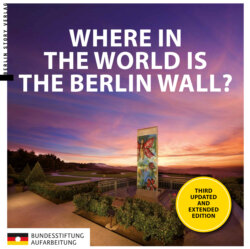Читать книгу Where in the World is the Berlin Wall? - Группа авторов - Страница 28
На сайте Литреса книга снята с продажи.
TIRANA ALBANIA Location: Martyrs of the Nation Boulevard
ОглавлениеThe Wall in Tirana
© Anna Kaminsky/Bundesstiftung Aufarbeitung
Anna Kaminsky at the ceremonious Wall unveiling
© Archiv Bundesstiftung Aufarbeitung
On 26th March 2013, a segment of the Berlin Wall was unveiled to a large crowd of joyous people. This section of the Wall was put up as a memorial to overcoming Enver Hoxha’s communist dictatorship. Albaninan Prime Minister, Sali Berisha, German ambassador, Carola Müller-Holtekemper and Mayor of Tirana Lulzim Basha all attended the unveiling. Anna Kaminsky, director of the Federal Foundation for the Study of the Communist Dictatorship in Eastern Germany, who had been the driving force behind the project to get a piece of the Wall to Tirana, was also in attendance.
The section of Wall given to Tirana by Berlin – 3.6-metres-high and weighing 2.6 tonnes – makes up one part of three works which are collectively known as “Post-Bloc” – a collection of memorials. It was erected in the centre of of Tirana, which was once restricted under communist leadership, and is today an area known for its nightlife. The section of Wall, a present from the city of Berlin, makes up part of a memorial complex called “Post-Bloc”. It can be found in the former Soviet exclusion zone on “Martyrs of the Nation Boulevard”, today a popular entertainment area in the heart of Tirana. Alongside the Wall section are concrete columns from Spaçi labour camp as well as a bunker. This bunker is symbolic of the almost 750,000 bunkers scattered throughout Albania. The memorial was designed by Albanian writer Fatos Lubonja, who was imprisoned in work camps and solitary confinement for 19 years as a political prisoner and artist.The memorial was designed by Adrian Isuffi and remembers the victims of Enver Hoxha’s Communist dictatorship from 1945 until Hoxha’s death in 1985.
Political opponents, intellectuals, land owners, Muslim and Christian clergy and farmers against collective farming were all seen as being against the regime and were killed in scores of bloody purges, sentenced to long prison sentences, or banished. The repression affected entire families, who were punished collectively. They were also banished or deported and forced into labour. Enver Hoxha’s repressive leadership style as well as the ever-present threat for Albanians from enemies, created an intimidated people filled with hate.
Albania’s political isolation lasted for over 40 years. It led not only to an extreme division of the country, but was a huge contributing factor to the impoverishment of the people. Ramiz Alia became the second and last Communist leader after Hoxha’s death in 1985. Despite making many economical reforms and making progress in international politics, he continued to lead according to Communist ideals. Protests, which began in late autumn 1990 and were mainly led by students, brought Ramiz Alia and his party into difficulties. In mid-December 1990, his party renounced its exclusive mandate. The formation of new political parties was permitted. The Social Democratic Party of Albania was formed in 1990 and was the direct successor of the Stalinist Communist party. The Democratic Party of Albania was formed in 1991. The Social Democrats won the first free elections in 1991. However, persistent unrest led to renewed elections barely a year later. Sali Berisha’s Democratic Party of Albania won this election with a two-thirds majority.
